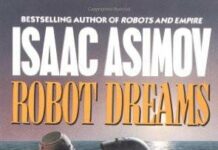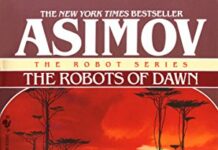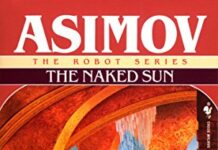
Ebook Info
- Published: 2013
- Number of pages: 497 pages
- Format: EPUB
- File Size: 0.39 MB
- Authors: Isaac Asimov
Description
From the writer whose name is synonymous with the science of robotics comes five decades of robot visions-36 landmark stories and essays, plus three rare tales-gathered together in one volume.From Publishers WeeklyNAL launches its new SF imprint, ROC, with a collection of 18 of Asimov’s ( Foundation ) robot stories. The earliest tales here, written from 1940 to 1960, remain among the most-loved in the field, the best being “Little Lost Robot,” about a robot who obeys an order to “get lost.” “The Bicentennial Man” (1976) about one robot’s desires and efforts to be first free, then equal, is the quintessential robot-as-man’s-mirror story. The book concludes with brief essays offering companionable commentary on the history of robots in fiction, the Frankenstein complex, the origin of Asimov’s famous Three Laws and the author’s own surprise at the emergence of robots during his lifetime. Copyright 1990 Reed Business Information, Inc.Review”This collection offers 18 stories about robots as well as brief essays in which Asimov comments on robots in fiction, the Frankenstein complex, his famous Three Laws and the development of actual robots. “The earliest tales here, written from 1940 to 1960, remain among the most-loved in the field,” —Publishers Weekly “Classic stories with new material, both fiction and fact, that puts the whole theme together in a larger context.” —Poul Andersen
User’s Reviews
Reviews from Amazon users which were colected at the time this book was published on the website:
⭐Just what I wanted. Mint condition hard cover book, fast delivery. Highly recommend.
⭐Great short stories as only Isaac can whoop them out. Of course, you MUST read all the books from the foundation series, as well as the “Empire” books. Those all go together though not intended to be that way when he began the first book. There’s 15 all together, I think. But it’s a journey that will blow you away. Just google search “what order do I read Isaac Asimov’s Foundation and Empire series of books.” You’ll get lists from several people. Make sure not to start with The Foundation series. Anyway, once you’ve read those 15 or so books, start on this, and Robot Dreams as well. I can’t believe I’m gonna do this for you, but what the heck. Here’s the order, all 15 books comprising some 2.5 MILLION words!!! 1)The Complete Robot 2) The Caves of Steel 3)The Naked Sun 4)The Robots of Dawn 5)Robots and Empire 6)The Currents of Space 7)The Stars Like Dust 8)Pebble in the Sky 9)Prelude to Foundation 10)Forward The Foundation (No matter what you hear, this is the slot to read this book) 11)Foundation 12)Foundation and Empire 13)Second Foundation 14)Foundation’s Edge 15)Foundation and Earth Well, there you go. I want to warn you, this is as good as it gets. You will never read another sci-fi series as good as the 15 books I’ve listed above, so enjoy, relish it, savor every word. When you’re done, you can read the rest of his works for dessert. Hope this helped. As you read, you will see how much stuff was “stolen” from him, especially little details like “hyperspace” and of course Robot stuff. Keep in mind he wrote much or most of this way back in the 1940’s and 50’s then shake your head in disbelief. Isaac is THE man.
⭐This book was ripped torn bruised and beaten like a red headed step book.Seriously, I mean this book went through hell and high water just to make it to my doorstep to be graced by my delicate mf fingertips. Hats off to you lil bookie.But I mean I don’t judge tho, the most important thing is that it’s readable I guess. I give it a full 5 stars.
⭐In this book, a collection of short stories about robots, Asimov points out the direction in which robotics might move in the future, which has become our present–a present some of which he lived long enough to witness. A good bit of the writing is dated, but then it would have to be given how long ago it was written and the state-of-the-art at that time. Nonetheless, Asimov points out the directions in which robotics (his own invented term,) might move as the state-of-the-art progresses.We live in an era in which robots serve many of the functions that used to be taken by humans performing the most menial tasks. As time progresses, we might see the role of robots increasing in our lives , a role which the author foresees and predicts as a near certainty.
⭐Bought this book to add to the Asimov Books already read—-half finished this book and it is a very good collection—easy read—if you like Robot books the following may be of interest to you,****Issac Asimov -****The Robot BooksAsimov had a sugested reading sequence HE published in Prelude to Foundation — for all the books he had written on robots—am listing that here – they were not written in sequence as you see. The Complete Robot – 1982 The Caves of Steel – 1954 The Naked Sun – 1957 The Robots of Dawn -1983 Robots and Empire – 1985 The Currents of Space – 1952 The Stars, Like Dust – 1951 Pebble in the Sky – 1950 Prelude to Foundation – 1988 Foundation – 1951 Foundation and Empire – 1952 Second Foundation – 1953 Foundation’s Edge – 1982 Foundation Earth – 1983peace and love—-
⭐This is more a complimentary book to I-robot than a stand alone collection. If you have not read I-robot, you should get that as well, as the two books are best consumed together and in close proximity to each other so that the differences between the two can be compared.The book also includes some of Asimov’s excellent non-fiction on the subject of robots, including his foundational theories about THE THREE LAWS.If you like robots and you’ve not read this book, you owe it to yourself to get a copy. Asimov is the grandfather of modern science fiction when it comes to all things robotic, and this book is a fantastic place to dig into the wealth of Asimov’s imagination on that topic.
⭐The style is old fashioned, which I could relate to, having been an Amazing Story and other sci-fi/fantasy magazine fan from my teen years back in the 60s. Probably not every story is first-person, and I really don’t recall how much violence was in the collection. What counts in my opinion is the quality of the story, not graphic gore. Altho I didn’t love every story in the collection, Asimov was for sure a good story teller. I learned more about the author than I knew before, and I enjoyed his sense of humor.
⭐Classic Asimov. I read most of these stories from library books; they are a time capsule of pre computer / Internet imaginings of “the future.”The only downcheck is the artwork; it should have been more period and less Star Wars.
⭐This is a retrospective collection of many of Asimov’s most famous and significant robot short stories that were written and published over a period of half a century, including seven of the nine stories in his classic “I, Robot” collection, from his first imagination of a robot childminder in 1939’s “Robbie”, through the early articulation of the three laws of robotics in “LIar” and “Runaround”, and later examinations where loopholes in the laws drive some ingenious plots. One story features the return of Elijah Baley and R. Daneel Olivaw from the classic robot novels “The Caves of Steel” and “The Naked Sun”. There is one new story in the collection, the title story which, unusually for Asimov, features time travel. The book is topped off by a collection of Asimov’s short essays and articles, again published over a period of several decades, on his thoughts about how real robots might work, and how they might relate to humans and improve our life experiences. This sequence begins with a 1954 article on his approach to the conceptualisation of robots in his fiction compared to the approaches of earlier authors. The other articles are from the 1970s and 1980s, fascinatingly exploring the relationship between the fictional and real development of robots and computers. Asimov’s writing is never less than engaging and the length of his writing career and his prolific output during 50 years of huge technological advance enable much interesting reflection and speculation about both positive and negative human reactions to technology.Finally, the stories contain a number of slightly odd illustrations of robots depicted in various scenes, but nearly all of which look exactly the same, not matching the very varied descriptions of robots given in the stories, which in fictional terms take place over probably two or three centuries of human development of robots.
⭐A reasonably good selection of Asimov’s short stories, with the emphasis on his robot stories as the name implies.I did enjoy it and was heartily relieved that (unlike Robot Dreams) it was relatively free from typos. However at £7.00 I consider it expensive for what it is. Although the essays and articles by Asimov which make up the second part of the book are interesting, I was originally going to gve it only 3 stars as I felt that we, the punters, were being robbed. As a collection it would have been far better value – and I would have cheerfully given it 5 stars – if, for example, the rest of the Martian Way stories or some of Asimov’s Mysteries had been included.Does anyone out there understand (or would Amazon be kind enough to explain) why the publication of Asimov’s work is so peculiarly patchy? I would have expected the original Foundation trilogy to have been amongst the first of Asimov’s work to have appeared in e-format but they are conspicuous by their absence. Two of the three original Robot novels are available on Kindle, but the third – The Robots of Dawn – is not.
⭐Robot Visions is a large collection of Issac Asimov’s short stories about robots, most of which appeared in various sci-fi magazines from 1940 up to the release of this collection in 1990, that’s a 50 year span. These aren’t all his robot stories, just some of his favorite’s and the choices are explained in the foreword by Asimov himself.There are 18 short stories and 16 short essays musing on robots in society. Many of the stories use recurring characters such as Susan Calvin (who was given a part in the Asimov inspired Will Smith film
⭐I, Robot
⭐in 2004, not related to the short story of the same name) and aren’t so much about robots who all fundamentally work based on Asimov’s famous three laws of robotics, but about peoples reactions to them, confusion, fear, even affection.The stories are consistantly good and often kept me interested in seeing how the problems are resolved. My favorite story of them all though is
⭐Bicentennial Man
⭐(turned into a reasonably faithful film in 1999 staring the late Robin Williams). Not only is it one of the longer tales in this collection but also is one of the deeper and I found emotional in some ways though whether it was intended that way by Asimov I do wonder.All in all a good collection of varied ideas about robots, if you’re a fan of any of his other works, especially his four main novels from the robot series this is worth checking out.The stories are:- Robot Visions (1990) (specifically written for this collection)-Too Bad (1989)- Robbie (1940)- Reason (1941)- Liar (1941)- Runaround (1942)- Evidence (1946)- Little Lost Robot (1947)- The Evitable Conflict (1950)- Feminine Intuition (1969)- The Bicentennial Man (1976)- Someday (1956)- Think (1977)- Segregationist (1967)- Mirror Image (1972)- Lenny (1958)- Galley Slave (1957)- Christmas without Rodney (1988)
⭐I read this collection years ago and really enjoyed it, but I found I had forgotten much of it. Re-reading was fun though many of the stories now seem a bit dated, and the essays more so.The writing style is easy to read and suited to the subjects, but in a few places I felt there had been a bit of padding. Since these were magazine published originally presumably they were written to length.On the surface the tales are light and short-lived but some of them deal with serious issues like the nature of death or what it is to be human.If there are any sci-fi fans who haven’t read this, then I recommend it to them.
⭐As history, these stories show how people used to think about the world and interact with each other, at least how they were expected to act in a work of fiction. The world has moved on from heavy mechanical robots; about as much as this style of writing.
Keywords
Free Download Robot Visions (The Robot Series) in EPUB format
Robot Visions (The Robot Series) EPUB Free Download
Download Robot Visions (The Robot Series) 2013 EPUB Free
Robot Visions (The Robot Series) 2013 EPUB Free Download
Download Robot Visions (The Robot Series) EPUB
Free Download Ebook Robot Visions (The Robot Series)





